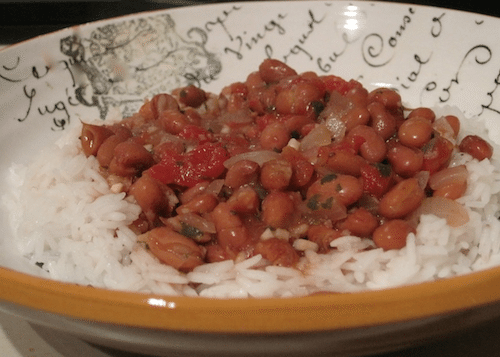July is Baked Bean Month
 July is Baked Bean Month! It's not too late to celebrate -- try our baked bean recipe tonight! But first, let's explore the joy of beans. Why dedicate a whole month to these legumes, especially in the produce-rich height of summer? Well, beans are pretty amazing. They are high in protein, fiber, vitamins, and minerals, yet low in sodium and fat. Beans can be magically transformed from a handful of pebbles to a pot full of deliciousness that has a small price tag and big flavor.Beans can be boiled, steamed, slow-cooked, or even barbecued, but, despite the heat, baking beans rates very high among summertime cooks. Baking brings out the sweetness and the tenderness in beans, while helping them retain their shape and texture.
July is Baked Bean Month! It's not too late to celebrate -- try our baked bean recipe tonight! But first, let's explore the joy of beans. Why dedicate a whole month to these legumes, especially in the produce-rich height of summer? Well, beans are pretty amazing. They are high in protein, fiber, vitamins, and minerals, yet low in sodium and fat. Beans can be magically transformed from a handful of pebbles to a pot full of deliciousness that has a small price tag and big flavor.Beans can be boiled, steamed, slow-cooked, or even barbecued, but, despite the heat, baking beans rates very high among summertime cooks. Baking brings out the sweetness and the tenderness in beans, while helping them retain their shape and texture.
Nearly Perfect
Baked beans are a nearly perfect dish, since they are creamy and saucy and can have flavors ranging from nutty to smoky. And of course, beans -- the star ingredient -- are very nutritious. Beans have no saturated fat and very little unsaturated fat (except for soybeans, which are relatively high in unsaturated fat). Beans are digested slowly, which makes them a great source of long-lasting energy. Depending on the type of bean you choose, beans can contain Vitamin A, iron, calcium, some B vitamins, zinc, and potassium. The fiber content in beans is tenderized during baking, but is still present in the dish.
Many Choices
Baked beans work equally well with dried, canned, frozen, or fresh beans. Which will you choose?
- With dried beans, you'll have to soak, boil, and cook them before baking. Simply follow the package directions and, in an hour or two, you'll have the beans you need for your dish.
- Canned beans should be rinsed. This removes some of the salt.
- Fresh or frozen beans may need to be briefly cooked before baking.
Select the bean form that best fits your lifestyle. If you have the time or want to choose the least expensive option, use dried beans. If you want to save time, choose fresh, frozen, or canned beans.
Baked Bean Success Tips
You need two key ingredients for baked beans: cooked, drained beans and a sauce in which to bake them. The sauce is used to moisten and flavor the beans.A rule of thumb for baking beans is to start with 2/3 of a cup of sauce for every cup of cooked beans. The beans will absorb a lot of the liquid. If you would like to emphasize a certain flavor, add it at the beginning of cooking. If you'd like just a hint of a flavor, add it during the last ten minutes of cooking. For example, if you would like to have an oniony bean casserole, finely chop onions and mix them with the beans before putting them in the oven. If you'd like just a whisper of onions, sprinkle them lightly over the beans just several minutes before removing from the oven.
Mix and Match
A classic New England baked bean recipe usually uses white beans, but this doesn’t have to be the rule. You can even use more than one type of bean for baked beans. For example, black and white baked beans make an elegant dish. Try your favorite bean varieties in our handy recipe (below) and celebrate Baked Bean Month tonight!
Traditional Baked Beans
- 1/2 tsp oil
- 1/4 cup chopped onions
- 1/2 tsp dry mustard
- 1/2 tsp black pepper
- 3 Tbsp cider vinegar
- 1/3 cup molasses
- 2 cups cooked white beans, rinsed and drained
Preheat oven to 350 degrees. Combine all ingredients in an oven-safe baking pan and mix gently. Cover and bake until mixture is thick and bubbly, about 30 minutes. Serve hot.Serves 4. Each 3/4 cup serving: 164 calories, 0.5 g fat, 0 g saturated fat, 0 mg cholesterol, 12 mg sodium, 34 g carbohydrate, 4.5 g fiber, 7 g protein. Diabetic exchange: 2 bread, 1/2 protein.By Nancy Berkhoff, RD, CECLooking for more ways to celebrate bean month? Check out the resources in our Nutrition Education Store!


